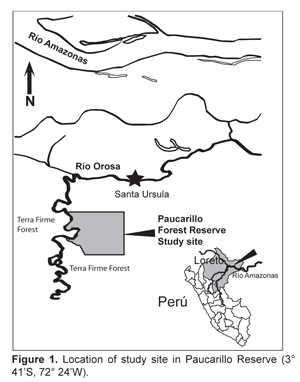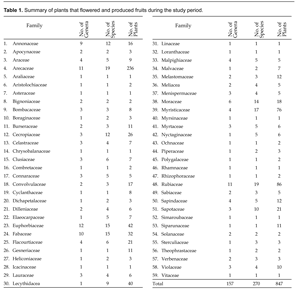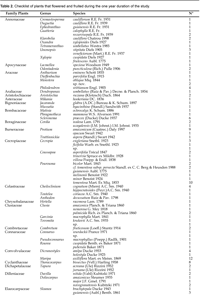Servicios Personalizados
Revista
Articulo
Indicadores
-
 Citado por SciELO
Citado por SciELO
Links relacionados
-
 Similares en
SciELO
Similares en
SciELO  uBio
uBio
Compartir
Revista Peruana de Biología
versión On-line ISSN 1727-9933
Rev. peru biol. v.14 n.1 Lima ago. 2007
Johanna P.S. Choo1,3; Rodolfo Vasquez-Martínez2 and Edmund W. Stiles1,4
1 Department of Ecology, Evolution and Natural Resources, Rutgers, The State University of New Jersey, USA.
2 Missouri Botanical Garden, St. Louis, Missouri, U.S.A.
3 Corresponding authors current address: Monitoring and Assessment of Biodiversity Program/NZP Smithsonian Institution, 100 Jefferson Drive, SW, Quad 3123, MRC 705, Washington DC 20560, U.S.A.
Email Johanna P.S. Choo: chooj@si.edu
4 Deceased.
Abstract
We recorded the diversity of flowering and fruiting plants during one year of phenological study at Paucarillo Reserve located in the northeastern part of the Peruvian Amazon (3°41' S, 72°24' W). A total of 270 species from 59 families were recorded, of which 57% were represented by only one individual plant. Arecaceae and Rubiaceae were the dominant families in this site.
keywords: fruiting plants, diversity, terra firma forest, north western Peru, Amazon
Resumen
En el presente trabajo damos a conocer la diversidad de floración y fructificación observada durante un año de estudio fenológico en la Reserva de Paucarillo (noroeste de la Amazonía Peruana 3°41' S, 72°24' W). Registramos un total de 270 especies en 59 familias, de las cuales el 57% son representadas solamente por 1 individuo. Las Arecaceae y Rubiaceae fueron las familias dominantes en este sitio.
Palabras clave:fructificación de plantas, diversidad, bosque de tierra firme, noreste Perú, Amazonas.
Introduction
This paper documents the species diversity of plants that were phenologically active (i.e. flowering and/or fruiting) during a one year period at a site in the Peruvian Amazon that is mostly unstudied. To date, most botanical studies in the Peruvian Amazon have been concentrated at a few established research sites in southern Peru, e.g. Manu (Foster 1990, Pitman et al. 2002). However, there has been detailed floristic surveys in northwestern Peruvian Amazon in two sites near Iquitos at Allpahuayo-Mishana (Gentry 1988, Malhi et al. 2002) and at the Explorama lodges (Vásquez Martínez 1997), which are located 122,7 km west and 77 km north-west of the study site described here. This project was part of a larger project to assess the productivity of vertebrate-dispersed fruit at Paucarillo. This paper adds to our growing pool of knowledge regarding the plant species diversity and distribution of Peru's lowland Amazonian plants.
Study site description
Our study was carried out in Paucarillo Reserve (3°41' S, 72°24' W), located in the Department of Loreto on the Rio Orosa (a southern tributary of the Amazon) (Fig. 1). This 500 hectare reserve encompasses primary igapo (black-water inundated forest) and terra firme forest and is owned by Project Amazonas (http://www.projectamazonas.com/), a non-profit organization based in Florida. Surrounding this reserve is primary forest that extends to the Brazilian border, so that the contiguous forest in this area exceeds 100000 hectares (D. Graham pers. comm.). Climate data from the nearest meteorological station in Pebas (4 o S, 73o W) managed by SENAMHI (Servicio Nacional de Meteorología e Hirología del Perú), 66,88 km northeast from the study site, recorded total precipitation of 3296,9 mm during the one year study period.

Materials and methods
The data presented here is part of a larger study of the birds and forest fruits in this area (Choo, 2005). Two study plots located in terra firme forest were established at the study site. In each plot, four parallel trails 90 m long and 50 m apart were established that served as mist-net lanes for capturing birds as part of another study, and were used for the phenological surveys described here. Each study plot consisted of 8 phenology lanes (each 90 × 10 m) flanking both sides of the net lanes. These phenology lanes covered an area of 7200 m2 per study plot. The total area surveyed for 12 months at this site covered an area of 14400 m2 or 1,44 ha.
Phenological data were collected from October 2001 to September 2002. Phenology surveys were conducted twice a month for 11 months and once for the month of December. During surveys, JC walked along net lanes to record the flowering and fruiting activity of all plants (herbs, shrubs, epiphytes, lianas and trees) found within the phenology belts. Two field assistants walked in tandem with her within the phenology belts to detect flowering and fruiting plants in the understory and to help detect flowering and fruiting canopy plants that she may have missed. When flowers or fruits were discovered on the forest floor, attempts were made to locate the source(s). Surveys were conducted visually and if necessary with the aid of binoculars (10×40 and 10×50).
All plants found flowering or fruiting were uniquely numbered with an aluminum tag. Plant habits were recorded as herb, shrub, epiphyte, treelet (subcanopy small trees), liana, tree (large canopy and subcanopy trees). Plants with easily recognized vegetative, floral and fruit characteristics were grouped in the field by JC into morphospecies and a representative voucher for each morphospecies was collected from those plants that subsequently produced fruit. All other plants that were not easily grouped were collected for identification. This method of identification meant that she was able to identify plants that flowered but failed to produce fruits based on the identity of their fruiting conspecifics.
Angiosperms and a few palms were identified at the Missouri Botanical Garden mostly by RV, with a few plants in Araceae, Menispermaceae and Rubiaceae identified by Thomas Croat, Rosa Ortiz-Gentry and Charlotte Taylor respectively. Most palms were identified at the New York Botanical Garden by Andrew Henderson. Vouchers were deposited in the institutions where they were identified, with duplicate vouchers deposited at AMAZ (Herbario Amazonense - Universidad Nacional de la Amazonia Peruana).
Results and Discussion
Floristic Description of Study Site
The canopy in this site is dense, with the majority of trees attaining heights of 15 — 40 m. The highest emergents consisted of trees and canopy palms approximately 50 m tall. The most diverse plant groups in this site were the Arecaceae and Rubiaceae, both with 11 genera and 19 species that flowered and/or produced fruits. Palms where the most abundant group of flowering and/or fruiting plants with 156 fruiting palms/ha. The second most abundant group was the Myristicaceae (second most speciose group) from which 50 fruiting plants/ha were phenologically active.
The canopy of this forest is dominated by large canopy palms (Attalea, Astrocaryum, Euterpe, Socratea and Iriartea), and tree species from the genus Eschweilera (Lecythidaceae). The subcanopy was dominated by the palm Astrocaryum murumuru and medium sized trees from the genus Iryanthera (Myristicaceae). The understory was dominated by palms in the genus Geonoma and shrubs in the genus Psychotria (Rubiaceae).
Species Richness of Flowering and Fruiting Plants
A summary of the diversity of flowering and fruiting plants in the study site is provided in Table 1, and a list of plants recorded flowering and fruiting in Paucarillo during the one year study period is shown in Table 2. The diversity of flowering and fruiting plants in this site is high, with 270 species from 59 families recorded during the 12 month study period over an area of 1,44 hectares or 188 species/ha.
Proportion of All Species that Flowered and Fruited during the Study Period
To compare the species richness of flowering and fruiting plants with total plant species richness in our study site, we examined data collected in a nearby site Madre Selva. In Madre Selva (3°37' S, 72°14'W), 19 km east of our study site, 304 species/ha (trees > 10 cm dbh excluding lianas, epiphytes and herbs) were recorded (Davila et al. unpublished data). Madre Selva has a higher diversity of trees > 10 cm dbh than Manu National Park in Peru's Madre de Dios region (174 species/ha) and Yasuni National Park in Ecuador (239 species/ha). To compare our results with the Madre Selva dataset, we excluded 61 species of lianas, epiphytes and herbs from our dataset, which reduced the number of flowering and fruiting tree species to 209 per 1,44 ha or approximately 145 species/ha. Assuming that our study site has the same total tree diversity as Madre Selva, this means that 48% of the total possible species richness (304 species) in this forest was recorded flowering and/or fruiting within our study site. Therefore 52% of plant species in our site were not flowering or fruiting because they were species (1) whose phenological activities were not recorded because they flowered and/or fruited between phenology surveys, (2) represented by non-flowering and non-fruiting immature individuals and / or (3) represented by mature individuals of rare species that did not flower and fruit during our study period due to supra-annual phenological cycles. However, it is also possible that our assumption is not correct and our study site may have lower species richness than Madre Selva.
Proportion of Rare Species
To compare the proportion of rare species between our site and Madre Selva, we arbitrarily defined rare species as those represented by 1—3 plants within 1—1,44 ha of forest. At Madre Selva, rare species accounted for 63% of all species in one hectare (Davila et al. unpublished data). Whereas, in our site rare species accounted for 57% of flowering and fruiting plants in 1,44 hectares. The high representation of rare species in both sites is consistent with the approximately 50% of species represented by one individual/ha at sites located within other parts of the Amazon (Faber-Langendoen and Gentry 1991, Valencia et al. 1994, Pitman et al. 2001). For detailed review of the distribution and rarity of Amazonian plants, we refer readers to Pitman et al. (1999 and 2001).
Acknowledgement
This paper is part of a dissertation project completed in partial fulfillment of JC's doctoral dissertation at Rutgers University. She would like to thank her Peruvian field assistants and hosts for fieldwork help and in-town housing respectively. JC thanks the Herbario Amazonense - Universidad Nacional de la Amazonia Peruana and Missouri Botanical Garden for access and use of their herbarium. D. Graham, R. Pezo and O. Gonzalez assisted with permits and provided in-country support. We thank INRENA for providing research and export permits. We are grateful for funding secured by J. Pearson from three Rutgers University benefactors.
Literature cited
Choo, J. P. S. 2005. The avifauna and wild fruits of two equatorial rainforest sites: An intertropical comparison. Thesis Ph.D. Rutgers, The States University of New Jersey, New Brunswick. [ Links ]
Faber-Langendoen, D., and A. H. Gentry. 1991. The structure and diversity of rain forests at Bajo Calima, Choco Region, western Columbia. Biotropica 23:2-11.
Foster, R. B. 1990. The floristic composition of the Rio Manu floodplain forest. In A. H. Gentry, editor. Four neotropical forests. Pages 99-111, Yale University Press, New Haven.
Gentry, A. H. 1988. Tree species richness of upper Amazonian forests. Proceedings of the National Academy of Science 85:156-159.
Malhi, Y., O. L. Phillips, J. B. Lloyd, T., J. Wright, S. Almeida, L. Arroyo, T. Frederiksen, J. H. Grace, N., T. Killeen, W. F. Laurance, C. Leano, S. Lewis, P. Meir, A. Monteagudo, D. Neill, P. Nunez Vargas, S. N. Panfil, S. Patino, N. Pitman, C. A. Quesada, A. Rudas-Ll, R. Salomao, S. Saleska, N. Silva, M. Silveira, W. G. Sombroek, R. Valencia, R. Vasquez Martinez, I. C. G. Vieira, and B. Vinceti. 2002. An international network to monitor the structure, composition and dynamics of Amazonian forests (RAINFOR). Journal of Vegetation Science 13:439-450.
Pitman, N., J. W. Terborgh, M. R. Silman, P. V. Núñez, D. A. Neill, C. E. Cerón, W. A. Palacios, and M. Aulestia. 2001. Dominance and distribution of tree species in upper Amazonian terra firme forests. Ecology 82:2101-2117.
Pitman, N. C. A., J. Terborgh, M. R. Silman, and P. V. Nunez. 1999. Tree species distributions in an upper Amazonian forest. Ecology 80:2651-2661.
Pitman, N. C. A., J. W. Terborgh, M. R. Silman, P. Nunez V., D. A. Neill, C. E. Ceron, W. A. Palacios, and M. Aulestia. 2002. A comparison of tree species diversity in two upper Amazonian forests. Ecology 83:3210-3224.
Valencia, R., H. Balslev, and G. P. Y. Mino-C. 1994. High tree alpha-diversity in Amazonian Ecuador. Biodiversity and Conservation 3:21-28.
Vásquez Martínez, R. 1997. Flórula de las Reservas Biológicas de Iquitos, Perú. The Missouri Botanical Garden Press, St. Louis.
Presentado: 17/04/2006
Aceptado: 23/04/2007















